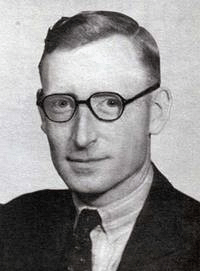While the release of the award-winning film “The Imitation Game” made Alan Turing a household name, stories of other WWII codebreakers lie buried in the historical archives.
One such codebreaker was Thomas H. “Tommy” Flowers, the engineer who designed the Colossus code-breaking machines.
On the heels of Enigma, the code Turing is credited with cracking, the German army asked the Lorenz Company to create the more complex Lorenz teleprinter cipher, which earned the codename “Tunny” by the British. By the time the war ended, ten Colossus machines had been built to wage a relentless battle against Tunny. The credit belongs to Flowers and his team of engineers.
From a working class upbringing to WWII civilian hero
Raised in a working class neighborhood in the East End of London, Flowers obtained a technical apprenticeship at the Royal Arsenal in Woolwich after finishing a mathematics fellowship at East Ham Technical School, says Thomas Haigh of the University of Wisconsin, Milwaukee and Siegen University.
Technical schools like East Ham prepared boys for trade apprenticeships, Haigh adds, “a good fit for Flowers who had for years been building mechanical and electrical devices with his fathers’ tools.”
In 1926, Flowers went to work for the Post Office, which ran Britain’s telephone and telegraph networks as well as its mail service. By 1932, Flowers had attained the rank of assistant engineer.
“The next year, he completed his university education, earning first class honors in the University of London examinations. This distinction was given to less than ten percent of the graduating class, quite a distinction at a time when less than two percent of the population held university degrees,” wrote Haigh in his article “Thomas Harold (“Tommy”) Flowers: Designer of the Colossus Codebreaking Machines” in the January-March 2018 issue of IEEE Annals of the History of Computing.
The code-breakers of Bletchley Park
Flowers worked with Turing on the Enigma project and, in 1944, was later put in charge of the team that built Colossus.
Thomas H. Flowers talks about his work on Colossus.
“The first Colossus is said to have included about 1,600 vacuum tubes. It was built and assembled at Dollis Hill under the close supervision of Flowers. Several other engineers contributed to the design, and much of the production and wiring was done by women,” says Haigh.
But Bletchly Park, the top-secret home of Turing and other WWII codebreakers, wanted more.
The team began work on the second Colossus in June 1944, just in time for D-Day. It incorporated many improvements and held around 2,400 tubes, capable of 4.55 times the performance of the first Colossus.
“By the time of the German surrender 10 Colossus machines were in use, equipped with a variety of little tweaks and unique capabilities to help with different tasks involved in the attack on Tunny,” Haigh writes.
A legacy in code-breaking and computer tech
Flowers passed away on 28 October 1998, but left behind a legacy that included not only Britain’s codebreaking efforts but the technology behind the MOSAIC computer built between 1947 and 1953 at London Underground station, Dollis Hill.
Recognition came late for Flowers—an honorary doctoral degree from Newcastle University in 1976 and the inaugural Martelsham Medal in 1980—but his work on Colossus has been undeniably established in the literature.
“His fame, and recognition, has grown further since his death in 1998, though despite a burgeoning literature on Colossus and Tunny, journalists still sometimes give credit for Colossus to Alan Turing or suggest that it targeted the Enigma code,” says Haigh.
It’s time to set the record straight.
